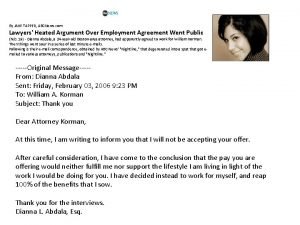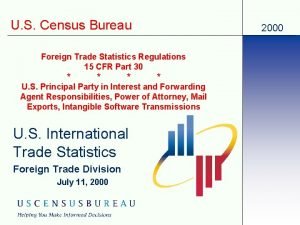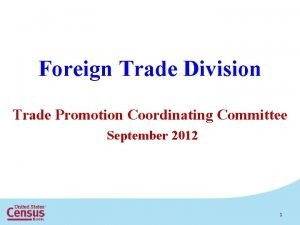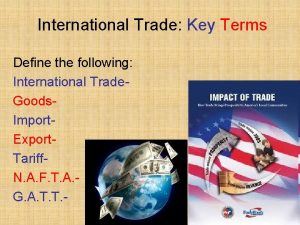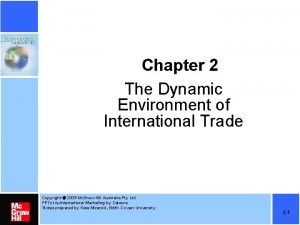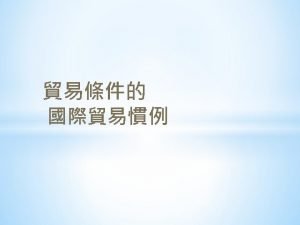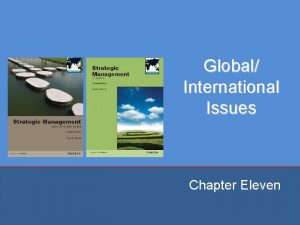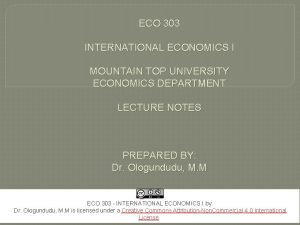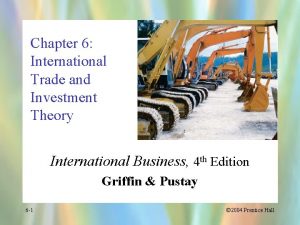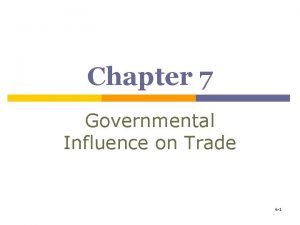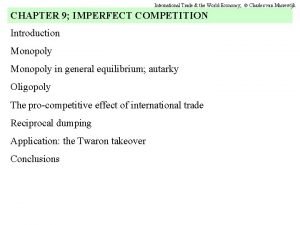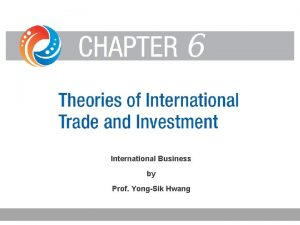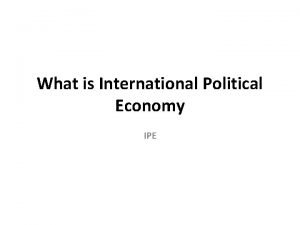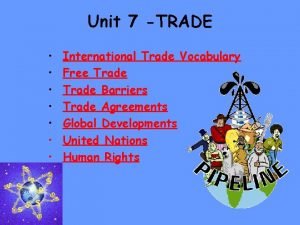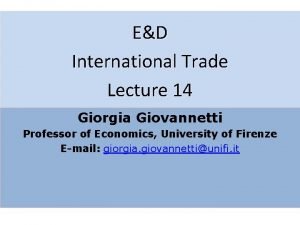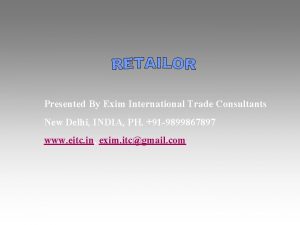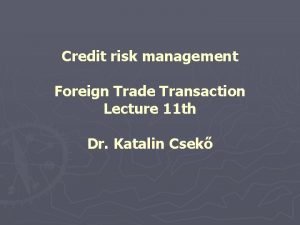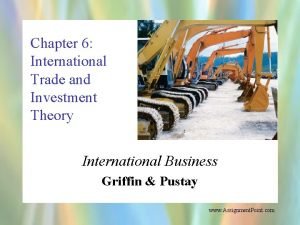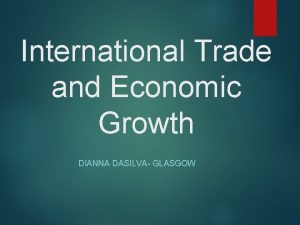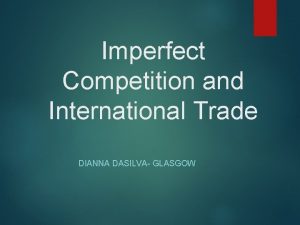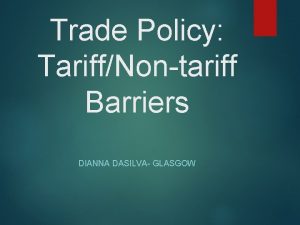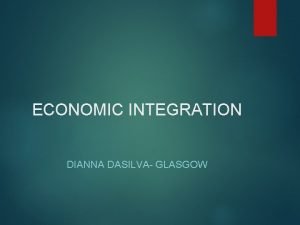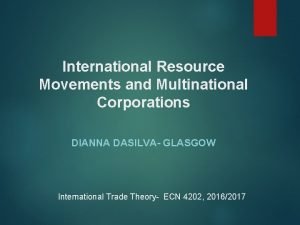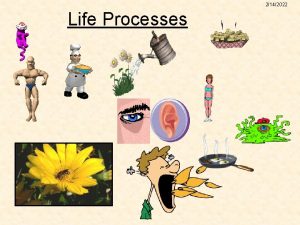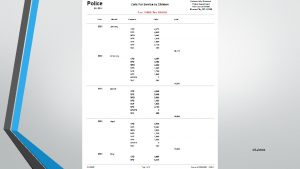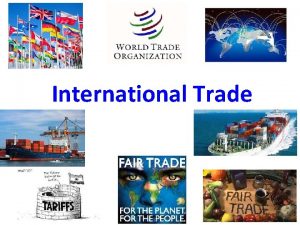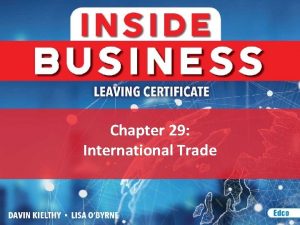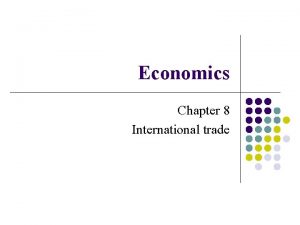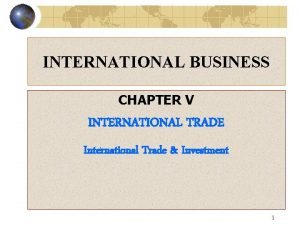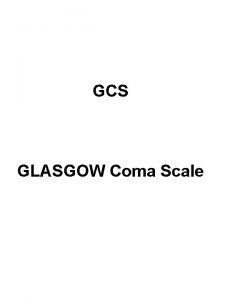REGULATIONS INTERNATIONAL TRADE DIANNA DASILVA GLASGOW 2 2142022


































- Slides: 34

REGULATIONS & INTERNATIONAL TRADE DIANNA DASILVA- GLASGOW

2 2/14/2022 OUTLINE Introduction costs Environmental Technical/ regulations Sanitary and phytosanitary regulations Labour regulations International Trade Theory. ECN 4202, 2016/2017 Transport

Relaxing In the real world there are barriers to trade in various forms, including transportation cost which affects industry location. International Trade Theory. ECN 4202, 2016/2017 assumption No. 9 - there are no transportation costs, tariffs, or other obstructions to the free flow of international trade. 3 2/14/2022 INTRODUCTION

TRANSPORT COSTS Transportation cost has two effects on international trade: 1. Changes the price of the traded commodity 2. Influences the location of production and industry International Trade Theory- ECN 4202, 2016/2017 2/14/2022 4

5 International Trade Theory- ECN 4202, 2016/2017 2/14/2022 WHAT ARE TRANSPORT COSTS? Shipping costs based on weight and distance Freight charges Storage costs Warehousing charges Insurance coverage Insurance premiums Interest charges for intransit goods

Pre-trade price difference in the two nations exceeds the cost of transporting the good from one nation to the other. Commodities where the transport and logistics cost outweigh the pre-trade price of the commodity will not traded on the international market. These are called non -tradables, e. g. haircut, cement (high weight-to- value ratio) 6 International Trade Theory- ECN 4202, 2016/2017 2/14/2022 BASIS FOR TRADE WITH TRANSPORT COSTS

Technology has converted many nontradable goods into tradables, e. g refrigerated trucks have made trade in perishable agri products more possible. 7 International Trade Theory- ECN 4202, 2016/2017 2/14/2022 BASIS FOR TRADE WITH TRANSPORT COSTS

8 International Trade Theory- ECN 4202, 2016/2017 2/14/2022 Partial equilibrium analysis of transport cost

1. Resource- oriented industries: industries that locate near the source of the raw materials because the cost of transporting the raw material is higher than the cost of transporting the final product which loses substantial weight during processing. 9 International Trade Theory- ECN 4202, 2016/2017 2/14/2022 TRANSPORT COST AND INDUSTRY LOCATION

2. Marketoriented industries: industries that locate near the market for the final product because there is substantial weight gain during processing which would make the finished good very expensive. 10 International Trade Theory- ECN 4202, 2016/2017 2/14/2022 TRANSPORT COST AND INDUSTRY LOCATION

3. Footloose industries: industries that follow cost inputs in order to lower manufacturing cost (have high value to weight ratios). Transport costs are not a factor in any stage of processing. 11 International Trade Theory- ECN 4202, 2016/2017 2/14/2022 TRANSPORT COST AND INDUSTRY LOCATION

Environmental standards and trade 12 standards refer to the levels of air, water, thermal (heat) pollution resulting from garbage disposal that a nation allows. Pollution arises whenever environment is abused. the International Trade Theory- ECN 4202, 2016/2017 2/14/2022 Environmental

How do environmental standards affect trade? Environmental pollution affects trade because the price of the traded good does not reflect the social environmental costs of pollution. 2. The environment can be used as a source of endowment or factor abundance in attracting polluting firms from abroad and achieving a comparative advantage in polluting goods and services. 1. 13 International Trade Theory- ECN 4202, 2016/2017 2/14/2022 Environmental standards and trade

Countries try to incorporate environmental standards in trade agreements to prevent the use of the environment as a means of achieving comparative advantage. Empirical support: Patrick Low (1992) found that dirty industries and their exports have expanded faster than clean industries and their exports in poor developing countries than in rich developed countries. 14 International Trade Theory- ECN 4202, 2016/2017 2/14/2022 Environmental standards and trade

Environmental regulations reflect the level of development of countries Richer nations voluntarily adopt more environmentally friendly policies/standards. Strong environmental standards are not supported during the early stages of development. 15 International Trade Theory- ECN 4202, 2016/2017 2/14/2022 Environmental standards and trade

Technical/ Sanitary and phytosanitary regulations SPSMs are any measure designed by importing countries: “to protect animal or plant life or health within the territory of the Member from risks arising from the entry, establishment or spread of pests, disease-carrying organisms or disease-causing organisms” (paragraph 1. a) “to protect human or animal life or health…from risks arising from additives, contaminants, toxins or disease-causing organisms in foods, beverages or feedstuffs” (paragraph 1. b) International Trade Theory- ECN 4202, 2016/2017 2/14/2022 16

TECHNICAL/ SANITARY AND PHYTOSANITARY REGULATIONS “to protect human life or health…from risks arising from diseases carried by animals, plants or products thereof, or from the entry, establishment or spread of pests” (paragraph 1. c); “to prevent or limit other damage…from the entry, establishment or spread of pests” (paragraph 1. d) Source: Annex A of the WTO SPS agreement International Trade Theory- ECN 4202, 2016/2017 2/14/2022 17

TECHNICAL/ SANITARY AND PHYTOSANITARY REGULATIONS What are SPSMs? “all relevant laws, decrees, regulations, requirements and procedures including: end product criteria; processes and production methods; testing, inspection, certification and approval procedures; quarantine treatments including relevant requirements associated with the transport of animals or plants, or with the materials necessary for their survival during transport; provisions on relevant statistical methods, sampling procedures and methods of risk assessment; and packaging and labeling requirements directly related to food safety. ” International Trade Theory- ECN 4202, 2016/2017 2/14/2022 18

i. the Codex Alimentarius Commission (CAC), which sets food safety standards; the ii. International Plant Protection Convention (IPPC), which establishes standards for plant health and iii. the Office of International Epizooties (OIE) or World Health Organization (WHO), which sets animal health standards. iv. Technical standards are covered by the International Organization for Standardization (ISO) 9001 (2008) quality management framework. 19 International Trade Theory- ECN 4202, 2016/2017 2/14/2022 INTERNATIONAL STANDARD SETTING BODIES

HOW DO THESE REGULATIONS 20 AFFECT TRADE? Measures must be based on scientific principles to avoid countries setting standards that are unnecessarily trade restrictive or discriminating (Article II. 2 -3). Regulations are heterogeneous across countries which increases the costs of exporting to several markets. International Trade Theory- ECN 4202, 2016/2017 2/14/2022

constantly make amendments to general food safety regulations that exporters must comply with. For instance the recent passage of the U. S. Public Health Security and Bioterrorism Preparedness and Response Act of 2002 (Bioterrorism Act), has made mandatory the registration of food processing, packing and storage facilities. 21 International Trade Theory- ECN 4202, 2016/2017 2/14/2022 HOW DO THESE REGULATIONS AFFECT TRADE? Developed countries use the precautionary principle to

Title 21 part 101 of the U. S. Code of Federal Regulations, which covers the requirements of the Federal Food, Drug, and Cosmetic Act and the Fair Packaging and Labeling Act. Directive 79/112/EEC and its amending regulations; including Directive 2000/13/EC and; Barbados National Standard 5: Part 2 and part 7 of 1994 on “Specification for Labeling of Prepackaged Food and Specification for Labeling of poultry, meat and other fishery products. 22 International Trade Theory- ECN 4202, 2016/2017 2/14/2022 EXAMPLE OF A SPS REGULATION Labeling regulations of the US, Barbados and the EU:

EXAMPLE OF A SPS 23 REGULATION These laws specify the following labeling requirements for imports International Trade Theory- ECN 4202, 2016/2017 2/14/2022 1. Name and nature of produce. 2. Foods that have undergone treatment (such as deep frozen) must bear an indication on the label. 3. A list of the common or category names of all ingredients in descending order of weight 4. Both the EU and Barbados stipulate indication of allergenic products or ingredients such as nuts and nut products, crustaceans and fish (Directive 2003/89/EEC). 5. The net contents; drained weight, for products in liquid medium; and count using metric units. the US requires the use of the avoirdupois pound but allows for the voluntary use of the metric system.

EXAMPLE OF A SPS 24 Date of minimum durability for all products. REGULATION The month and date can be used for products that have a shelf 6. life of less than three months while, the month and year alone can be used for products with a shelf life exceeding eighteen months. 8. Barbados and the EU require that the shelf life of products be preceded by statements such as “Best before. . . ” (When the date includes an indication of the day); or “use by” (for highly perishable products) or any other approved language. Barbados has additional requirements that relate to the numerical declaration of the day and year. 9. Each country also stipulates the inclusion of temperature conditions for storage. International Trade Theory- ECN 4202, 2016/2017 2/14/2022 7.

EXAMPLE OF A SPS Labels must carry the name and address of the manufacturer REGULATION of the product as well as the local packer or distributor; 25 10. 11. For Barbados and the US, labels must be in the English Language. However the use of a foreign language is not strictly prohibited. For the EU, labels must be in the official language(s) of the member state(s) to which the product(s) is (are) exported or any other language or representation that can be understood by consumers. The EU operates in 26 languages. International Trade Theory- ECN 4202, 2016/2017 2/14/2022 including a reference to the country of origin. Additionally, the US requires that products that were manufactured; packed or distributed for another company be stated as such.

EXAMPLE OF A SPS 26 Information surrounding commercial specifications that relate to REGULATION grade, class, size and other quality factors must be provided. For 12. International Trade Theory- ECN 4202, 2016/2017 2/14/2022 the US and the EU these specifications are explicitly described in the marketing standards for products such as fresh F&V. 13. Barbados and the EU require that each container/product be marked to identify the marketing plant and lot to which the product/container belongs. 14. Nutrition labeling is only mandatory where a nutrition or health claim is made for a product (Council Directive 90/496/EEC and 1924/2006). However, Barbados requires that each package of fish display an appropriate health mark. For the US, the Nutrition Labeling and Education Act of 1990 made nutrition labeling mandatory for several products.

15. Labels must follow certain presentation requirements that relate to the format of displaying labeling information, including the size of words and numbers and the type of numerals (such as Arabic or Roman) used. 27 International Trade Theory- ECN 4202, 2016/2017 2/14/2022 EXAMPLE OF A SPS REGULATION

28 International Trade Theory- ECN 4202, 2016/2017 2/14/2022

LABOUR REGULATIONS The internationally recognized core labour standards are relevant to trade. These are comprised of the following four ‘fundamental’ principles: 1. Freedom of association and the effective recognition of the right to collective bargaining; 2. The elimination of all forms of forced or compulsory labour; 3. The effective abolition of child labour; and 4. The elimination of discrimination in respect of employment and occupation. International Trade Theory- ECN 4202, 2016/2017 2/14/2022 29

LABOUR REGULATIONS Forced Labour Convention (1930) No. 29 ratified by Guyana on 08/06/1966 Abolition of Forced Labour Convention (1957) No. 105 ratified by Guyana on 08/06/1966 Freedom of Association and Protection of the Right to Organize Convention (1948) No. 87 ratified by Guyana on 25/09/1967 Rights to Organize and Collective Bargaining Convention (1949) No. 98 ratified by Guyana on 08/06/1966 Equal Remuneration Convention (1951) No. 100 ratified by Guyana on 13/06/1975 International Trade Theory- ECN 4202, 2016/2017 2/14/2022 These principles are based on the following Conventions: 30

LABOUR REGULATIONS Discrimination (Employment and Occupation) Convention (1958) No. 111 ratified by Guyana on 13/06/1975 Minimum Age Convention (1973) No. 138 ratified by Guyana on 15/04/1998 Worst Forms of Child Labour Convention (1999) No. 182 ratified by Guyana on 15/01/2001 International Trade Theory- ECN 4202, 2016/2017 2/14/2022 31

such regulations to determine which products can enter their market (E. g. CARICOM- Canada FTA). The concern is that low labour standards can provide a source of competitive advantage. Therefore forcing countries to implement high standards will erode a source of competitive advantage. 32 International Trade Theory- ECN 4202, 2016/2017 2/14/2022 HOW DO LABOUR REGULATIONS AFFECT TRADE? Developed countries intend to use compliance with

Pre-trade price difference in the two nations must exceed the cost of complying with the regulations of the importing country. 33 International Trade Theory- ECN 4202, 2016/2017 2/14/2022 BASIS FOR TRADE WITH REGULATIONS

2/14/2022 Salvatore (2007) , Chapter 6 34 Further reading International Trade Theory. ECN 4202, 2016/2017
 Dianna kokoszka net worth
Dianna kokoszka net worth Dianna abdala
Dianna abdala Dianna snape
Dianna snape Routed export transaction
Routed export transaction Foreign trade regulations ftr
Foreign trade regulations ftr What was the triangular trade
What was the triangular trade Trade diversion and trade creation
Trade diversion and trade creation Fair trade not free trade
Fair trade not free trade Umich
Umich Trade diversion and trade creation
Trade diversion and trade creation Which is the most enduring free trade area in the world?
Which is the most enduring free trade area in the world? Tramp trade software
Tramp trade software The trade in the trade-to-gdp ratio
The trade in the trade-to-gdp ratio International trade key terms
International trade key terms International rules for the interpretation of trade terms
International rules for the interpretation of trade terms Advantages of international trade
Advantages of international trade Dynamic environment of international trade
Dynamic environment of international trade Current theory of international trade adalah
Current theory of international trade adalah International rules for the interpretation of trade terms
International rules for the interpretation of trade terms Types of international trade
Types of international trade Disadvantages of international trade
Disadvantages of international trade Eco 303
Eco 303 Chapter 6 - theories of international trade and investment
Chapter 6 - theories of international trade and investment Essential industry argument
Essential industry argument International trade
International trade Theories of international trade and investment
Theories of international trade and investment International political economy
International political economy International trade vocabulary
International trade vocabulary Ifslearning
Ifslearning Strategic trade theory
Strategic trade theory International trade
International trade Exim international trade consultants
Exim international trade consultants Diftz
Diftz Credit risk in international trade
Credit risk in international trade International trade theory
International trade theory

